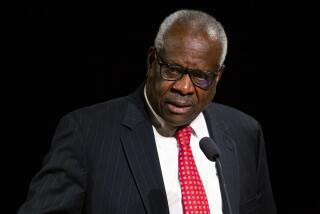In the Eye of the Beholder: States’ Rights, Federalism
- Share via
Dividing human activity as belonging either to the states or to the federal government does not work. This is the central lesson of the last five weeks; what happens in Florida is both local and national. The U.S. Supreme Court’s effort to allocate authority to one or the other level misses that both are inevitably involved.
We have heard the word “federalism” many times lately. A refresher course is in order, with a reminder of news that only last spring was hot off the press.
When the court broke new federalism ground. On May 15, Chief Justice William Rehnquist wrote on behalf of a five-person majority in United States vs. Morrison that one part of the 1994 Violence Against Women Act--its civil rights remedy--was unconstitutional.
According to Rehnquist, Congress had exceeded its constitutional powers when providing a federal cause of action for victims of violence who were targeted because they were women. Why? Because, Rehnquist said, “The Constitution requires a distinction between what is truly national and what is truly local.”
The four dissenters argued that the court had no business substituting its judgment for that of Congress, which, after four years of hearings, had concluded it should use both its Commerce Clause and its Equal Protection Clause powers to create a new civil rights remedy.
In support of its Commerce Clause powers, Congress relied on how much the threat of violence organized women workers’ lives--that they, for example, chose certain jobs and avoided others, fearing for their safety on late-night public transportation. For its Equal Protection power, Congress cited more than 20 official state court reports, concluding that women victims of violence faced problems of biased treatment. Chief law enforcement officials from 40 states told Congress they could use federal help. In short, Congress decided that women’s capacity as equal economic actors was at stake.
The Supreme Court majority in Morrison rejected Congress’ claim that this was a civil rights problem and instead called it a problem of criminal law, a topic the court claimed belonged to state law. Further, the court warned that, were violence against women to be within the Commerce Clause powers, then “family law and other areas of traditional state regulation” could be as well. The five-person majority in essence told the country that their understanding of federalism required invalidation of this federal statute.
The decision in Morrison does not stand alone. Over the last six years, in the name of federalism, the same majority of five insistently expanded the reach of the 11th Amendment, which provides for some form of states’ sovereign immunity, and narrowed the reach of congressional power under the 14th Amendment, which provides for equal protection of the laws.
Yet this past Saturday, these very same five justices stayed the Florida high court’s order about counting votes for the presidency and Tuesday night imposed impossible conditions on a recount. Readers of that court’s decision know that of the seven state justices, six had thought the issue was governed by state law and that the trial judge had erred. A majority of four also concluded that a recount was required.
When that decision came to the U.S. Supreme Court, four of its justices--the very same four who had dissented in Morrison--again warned against the majority taking too much power to itself. In Morrison, the majority had overturned Congress’ statute. Last Saturday, the same majority stayed a state court decision. And so it was the dissenters who this time relied on “federalism” in arguing that the majority was invading states’ powers and the court’s own traditions of self-restraint.
What have we learned about federalism in the last several months? First, the rhetoric of it can be and has been invoked by all justices, whether they are perceived as conservative or liberal.
Second, the Constitution under-specifies exactly how federalism is supposed to work. The word itself appears nowhere in the constitutional text.
Third, the chief justice’s effort in Morrison to claim that the Constitution requires a distinction between the categories “local” and “national” is misguided, in the sense that, practically and factually, governance can be and often is shared. Take any area--crime, family law or election law--and you will find that state and national laws are both at work.
As the Violence Against Women Act ruling and the election cases make plain, the decision to conclude that either the federal or state courts have jurisdiction does not flow from nature or from some simple reading of a few lines from the Constitution. Humans--nine justices--draw that line. And unfortunately, not always consistently with their own prior rulings. Prudence requires the five who stopped the Florida recount explain how their vigorous pursuit of states’ rights squares with their recent actions.
Any of us who have the energy to tear our eyes away from election events should notice actions by other branches of government. In a series of localities--New York City, Arizona and Illinois--city and state officials have been thinking about the problem of violence against women. Last week, the New York City Council passed the Victims of Gender-Motivated Violence Ordinance, providing a civil damages remedy for victims. The City Council expressly acted to fill the “void” left by the U.S. Supreme Court’s Morrison ruling striking the national legislation. Both the legislatures of Arizona and Illinois have similar bills to consider.
The “local” and the “national” are constantly in conversation, and from these recent “local” efforts to redress violence against women, we all should be reminded of the import--rather than the constitutional mandate--of working at all levels of the government to bring about a fairer social order.
More to Read
Get the L.A. Times Politics newsletter
Deeply reported insights into legislation, politics and policy from Sacramento, Washington and beyond. In your inbox twice per week.
You may occasionally receive promotional content from the Los Angeles Times.










